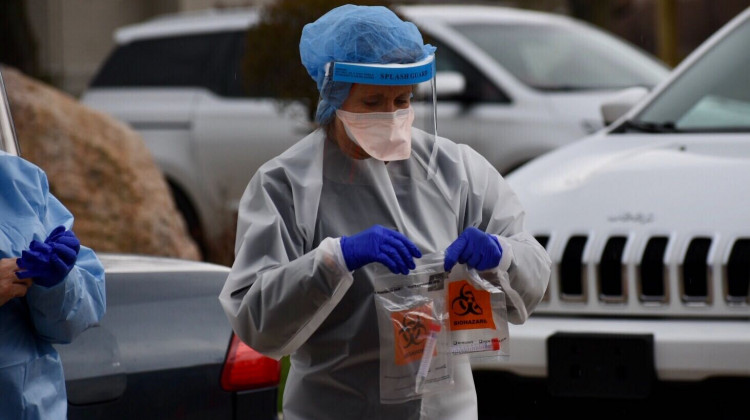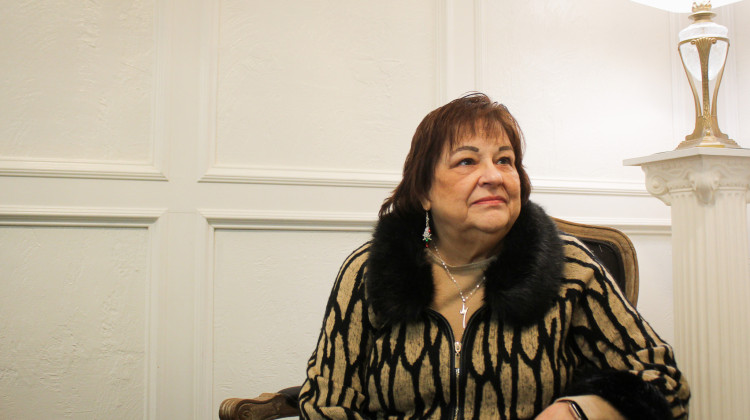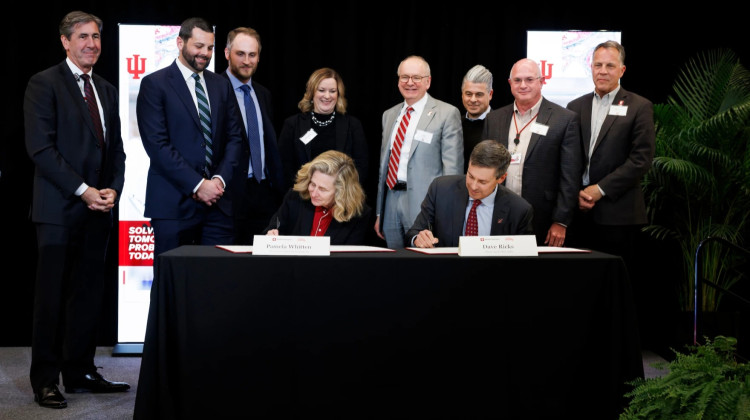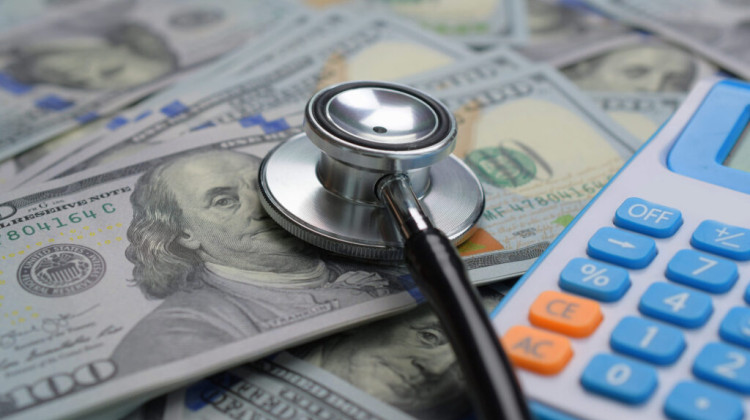
Unless Congress acts to increase COVID-related spending, COVID tests and treatments will no longer be guaranteed free for uninsured people.
(Justin Hicks/Indiana Public Broadcasting)At the start of the pandemic, many wished there was a pill people could swallow to make a COVID-19 infection go away. Two years later, we have not just one, but two of those pills, in addition to other outpatient and inpatient treatments.
The federal government established programs in 2020 to ensure access to COVID care regardless of insurance status. But studies show life-saving treatments have not been equally accessible to all who need them. Among people who tested positive for COVID-19, patients of color were less likely to access monoclonal antibody treatments, according to an analysis from the U.S. Centers for Disease Control and Prevention.
In mid-March, Congress rejected pleas from the White House to pump more money into programs meant to remove barriers to COVID care and assist the most vulnerable. This means COVID tests and treatments will no longer be guaranteed free for uninsured people. Public health experts expect the situation will worsen disparities in treatment access and other COVID-related care, just as another subvariant could soon cause a new wave of cases.
“We have a pattern in the United States of pumping a lot of money into public health during an emergency, and then cutting back once the emergency is over,” said Jeffrey Levi, professor of health policy and management at George Washington University. “I think what we're seeing now is for the first time, Congress actually cutting back in the middle of an emergency, which is even worse.”
The “boom and bust cycle,” he said, makes it nearly impossible to sustain improvements in health equity. And it’s the nation’s most vulnerable who suffer.
For example, the federal government will halt the program established in May 2020 to reimburse providers for testing and vaccinating people against COVID. Now, those who are uninsured or underinsured could be billed for vaccines and COVID tests.
“What I see playing out is: uninsured people avoiding COVID-related care. For low-income individuals, even relatively small co-payments will inevitably push people away from getting tested,” said Dr. Adam Gaffney, a frontline pulmonary and critical care physician and professor at Harvard Medical School.
That could hamper infection control and worsen COVID data and surveillance efforts. More importantly, Gaffney said, it will make the nation’s most vulnerable unable to access effective treatments, like oral antiviral pills and monoclonal antibodies. Some of these medications have been shown to cut the risk of hospitalization or death for high-risk patients by as much as 89 percent. But to get one of these treatments, you need a positive COVID test and a prescription.
“We're beginning to treat COVID more like any other illness: care being rationed by ability to pay,” he said. “And that's the exact opposite of what we should be doing.”
A system that ‘favors the wealthy’ could get even more inequitable

Even with federal dollars flowing, uninsured people were more likely to be infected with the coronavirus and less likely to get tested for it. They were also less likely to get vaccinated, even though vaccines were free.
But that does not mean that the programs weren’t used. According to Gaffney’s analysis of CDC data, the program covered nearly $19 billion worth of services, including $6 billion in treatment, $1.6 billion in vaccines and $11 billion in COVID testing for the uninsured.
That’s all going away if federal lawmakers don’t move to restore funding.
Funding cuts mean COVID treatments, which are already in limited supply, will become even more scarce.
The federal government has purchased millions of doses of four outpatient COVID treatments. Most of the supply is distributed via state health departments to hospitals, pharmacies and clinics that request doses. A portion has been set aside for direct shipment to clinics that operate in underserved communities disproportionately affected by COVID-19.
The White House has said the supply could run out as early as late May if funding is cut.
When supplies are scarce, designing systems for fair allocation becomes even more important to ensure equity, said Dr. Douglas White, endowed chair of ethics in critical care medicine at the University of Pittsburgh Medical Center.
But many states have not done that, he said, opting for a “first come, first serve” system.
“We know that ‘first come, first serve’ favors the wealthy and well-connected,” White said. “And for people who have poor health care access, ‘first come, first serve' basically puts them at the back of the line.”
About 9 percent of the U.S. population is uninsured, and Black and Hispanic Americans are more likely to be uninsured compared to White Americans, according to data from the U.S. Census Bureau.
States aren’t tracking who’s getting COVID treatments
Most states have no information about who receives outpatient COVID treatment, because they are not asking for it.
After setting aside 15 percent of the therapeutics for health centers that cater to underserved populations, the federal government left it up to each state to decide how to distribute the remaining 85 percent.
Health officials in many states have steered supplies to major hospital systems and commercial pharmacies, where anyone with a prescription can receive them.
But other states, like Minnesota, tried a different approach. The state is restricting the distribution of the oral antiviral Paxlovid to health facilities where a system is in place to prioritize patients who need it most.
JP Leider, director of the Center for Public Health Systems at the University of Minnesota School of Public Health, helped develop Minnesota’s allocation system. He said the approach makes it possible for high-demand drugs in low supply to be reserved for the most at-risk patients, taking that burden off of places like commercial pharmacies.
The federal government provided guidance about who is clinically eligible for the treatments, but that still left some discretion up to the states.
During the omicron wave, for example, Leider said there were up to 10 clinically eligible patients waiting per dose of the monoclonal antibody treatment in Minnesota. Most states experienced similar scenarios of extreme shortages.
The federal government also does not require providers to track or report demographic information about who receives the treatments. So, many states across the Midwest, including Ohio, Indiana and Illinois, don’t require it either.
This concerns Dr. Giselle Corbie, director of the Center for Health Equity Research at the University of North Carolina Chapel Hill.
“The reality is that these data are critically important,” she said. “Health inequalities disappear when we stop collecting data on race and other social identities, but the impact does remain.”
Corbie worries disparities in access to health care will be exacerbated as programs that aimed to foster equity of access to COVID care come to an end.
Beth Rwoble, CEO of HealthLinc, a federally qualified community health center in Indiana, shares those concerns. For now, she said the center still has “a lot of” tests, vaccines and treatments to serve the uninsured, but the funding cuts will create other challenges for her clinic.
“We are so used to having to find ways to serve our uninsured. This is just another barrier that we need to find a way to go over,” Rwoble said. “My wish is that we had more of a heads up.”
People can’t access a treatment they don’t know exists
Even though the supply of COVID therapeutics has been limited, Rwoble said demand has been lower than she expected.
Until recently, HealthLinc in Valparaiso, Indiana, was the only federally qualified health center in the state that received direct shipments of the new COVID antiviral drugs. Rwoble said the clinic received 245 doses in January. But as of mid-March, only 60 doses — less than a quarter of the supply — had been used.
Federal data shows millions of doses are also sitting unused on shelves in pharmacies around the country, according to reporting from NPR.
Rwoble said she wonders if people aren’t getting as sick as they were earlier in the pandemic and as a result have not sought out COVID treatment.
Low demand may also be due to lack of awareness about the treatments and knowledge about how to get them.
The White House launched a new website, COVID.gov, which aims to make it easier for people to find COVID treatments, tests and vaccines.
But even if people are aware of the treatments, it doesn’t guarantee equitable distribution. Dr. William Trick, director of the collaborative research unity and a hospitalist at Cook County Health in Illinois, said racial minorities and underserved populations are the ones who likely need treatments the most but are least likely to access them.
Trick co-authored a CDC study that found relatively equal access to inpatient treatments once patients were sick enough to be hospitalized. But for outpatient treatments, like monoclonal antibodies, researchers found from November 2020 through August 2021, Hispanic patients received treatment 58 percent less often than non-Hispanic patients, and Black and Asian patients received treatment 22 percent and 48 percent less often, respectively, than White patients.
Part of the reason could be people of color are more likely to face barriers, like inability to take time off work when sick and less access to primary care physicians. As a result, Black and Hispanic patients may not seek care until they’re seriously ill and require hospitalization.
“The problem isn't just one of distribution,” Trick said. “It's how do you get the people to know about the medication and come to the right clinical setting to get the medication?”
This story comes from a reporting collaboration that includes the Indianapolis Recorder and Side Effects Public Media — a public health news initiative based at WFYI. Follow Farah on Twitter: @Farah_Yousrym.
9(MDAyMzk1MzA4MDE2MjY3OTY1MjM5ZDJjYQ000))
 DONATE
DONATE







 View More Articles
View More Articles



 Support WFYI. We can't do it without you.
Support WFYI. We can't do it without you.